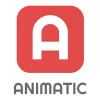Take a look inside 6 images
Animatic
Pros: The minimal design makes it easy to learn the basics behind animation.
Cons: Not a ton of features: If you want a library of images to animate or more export options, look elsewhere.
Bottom Line: This animation app can be a great starting point for learning the essentials of animation (sequencing frames of drawings), but ultimately it has a small feature set compared to others.
If a picture is worth a thousand words, then a video or animation of a process can be invaluable in the classroom. Students could turn to Animatic to create simple illustrations of concepts. For instance, students could demonstrate science concepts, such as animating the rock cycle, or create a simple animated timeline for a history class. In a media or film class, students could storyboard scenes and get feedback from peers on their directorial vision. Since students can export their animations as videos or GIFs, it's easy for students to embed their creations in presentations, class blogs, or even email. For art or media teachers, Animatic could be a first step toward helping students understand the bare-bones mechanics of animation and digital drawing.
Animatic is an app for drawing and exporting simple animated GIFs and videos. It works on iOS and Kindle, and there's a free and paid version. With Animatic, you can draw with your fingers or an inexpensive pen stylus. Start with a blank canvas and draw your ideas, write text, add frames, and then export to one of two available file formats. Tap to change drawing tools (pen, highlighter, etc.) and colors, add a new frame, change animation speed, and export. Upload the videos and GIFs to a website or social media platform. If you want to add sound, export your creation to video and open it in your favorite video editor app. Users can duplicate animations to make variations on original creations, and there are also a few pre-made animations offered as starting points in the app.
The Animatic Instagram feed is full of interesting and some quite impressive animations created with the free and Pro versions of the app, though some are not appropriate for younger viewers. Experienced animators will likely prefer the Pro version, which includes adjusting frame duration, repeating frames, advance onion skinning (previewing previous frames) for creating smoother transitions, and higher frame rate for exports (24 fps).
While other tools in this category offer libraries of images and backgrounds to work with and more options for tweaking animations and file exports, Animatic errs on the side of minimalism to unlock creativity.
Animatic is a good basic tool for learning how to make animations with frames. Anyone who has used drawing or painting apps will find Animatic very easy to learn and intuitive -- which is good since there's no tutorial or instruction (although there are some sample animations students can tweak). It has a no-frills interface, which makes it easy to just jump in and go, but it also could be too simplistic for students after they've gotten the gist. The help files for the app are slim, so educators may want to support learning by teaching relevant animation terminology and concepts such as frames, onion skinning, frames per second (fps), and the difference between video and GIF formats. For students with a strong interest in digital animation, teachers may want to direct them to animation tools with more features, such as FlipaClip or Animation Creator HD.














